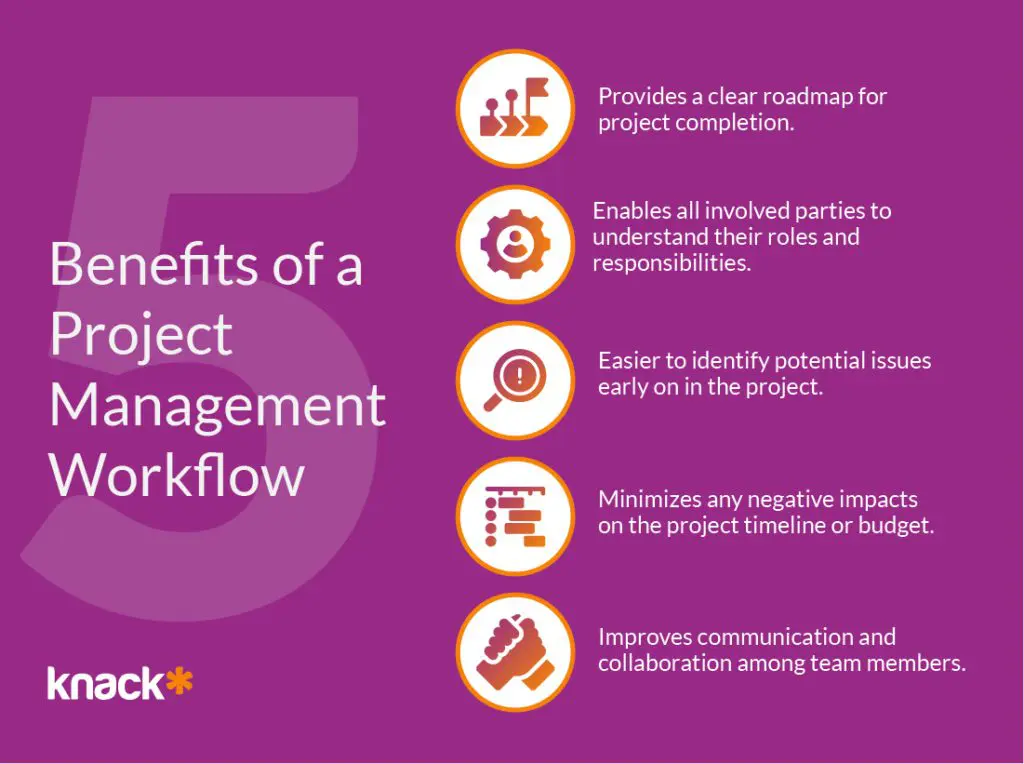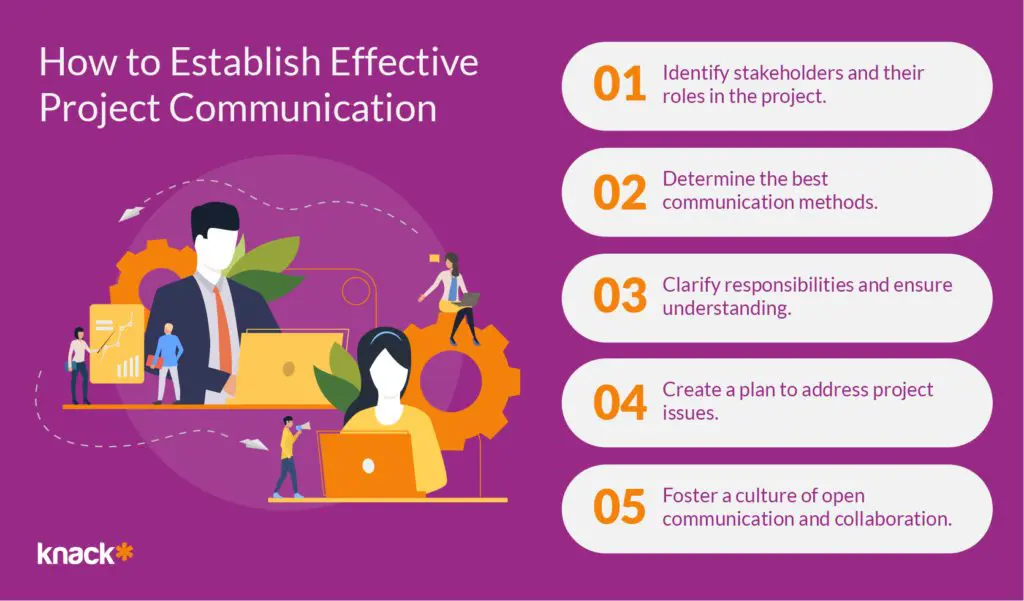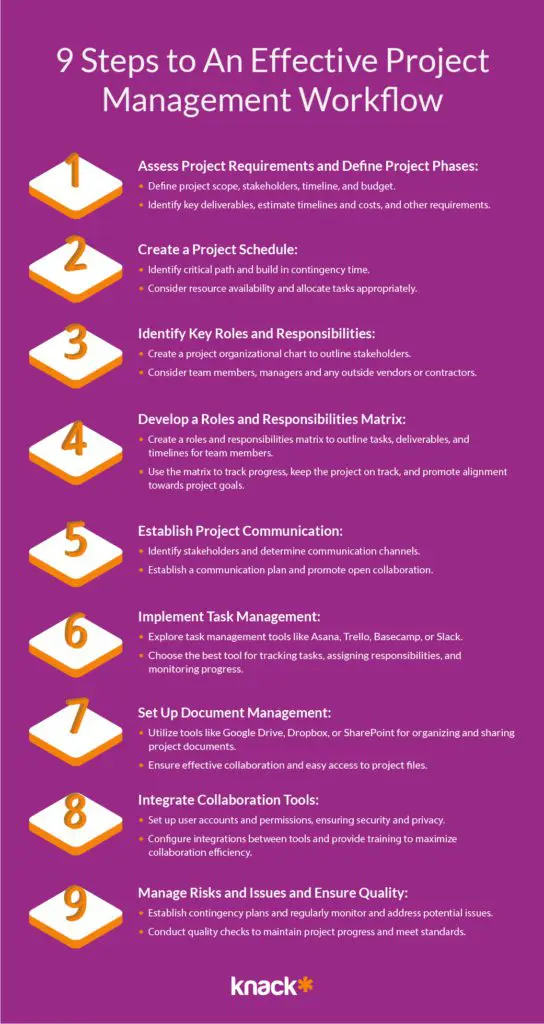
If you’re involved in ensuring that projects happen on time management, you know just how complicated and overwhelming it can be! You need to stay organized, communicate effectively, and manage your team to ensure that projects are completed on time, within budget, and to the satisfaction of all stakeholders involved. A central part of achieving these goals is having a strong project management workflow in place & well documented.
So, in this article, we’ll provide you with a step-by-step guide for creating an effective workflow for your project management needs. Before diving into the specifics of creating a workflow, it’s important to understand what project management workflows are and how they can benefit a project. Even if your organization is already using project management databases across your company it’s important to make sure that the fundamentals are in place for success.
Understanding Project Management Workflows
Significant quantities of jargon get thrown around within industries and in the world of project management. We’ll start with some fundamentals before covering some core concepts you need to understand moving forward.
What is a project management workflow?
A project management workflow is the outline of tasks and processes that are necessary to achieve a project’s goals in a timely manner. It’s typically broken down into different phases, with each phase containing various tasks, stakeholders, and responsibilities that need to be completed in order for the project to move forward.
By ensuring that everyone is following the same process and is aware of what their responsibilities are, you can reduce the likelihood of mistakes and misunderstandings that could potentially stall a project’s progress.
An important aspect of project management workflows is that they are adaptable. While there are general guidelines and best practices that can be followed, each project will have its own unique set of requirements and challenges. Often you, or your project manager, will have to tackle these issues as they evolve. The ability to adapt from a firm foundation is why project management workflows are so valuable.
How Does a Project Management Workflow Benefit a Project?

There are multiple benefits to getting a project management workflow to manage the stages of your project. Here are a few:
- Provides a clear roadmap for project completion.
- Enables all involved parties to understand their roles and responsibilities
- Easier to identify potential issues early on in the project
- Minimizes any negative impacts on the project timeline or budget.
- Improves communication and collaboration among team members.
The 9-Step Guide to Set Up a Project Management Workflow
There are multiple phases you need to go through in order to set up your project management workflow correctly. Here is a detailed run-down of what you need to do!
1) How Do You Assess Project Requirements?
The first thing you need to do when setting up a project management workflow is assess the project requirements and define the different phases of the project. This is a crucial step, as it lays the groundwork for the entire project and ensures that everyone is on the same page with regards to what needs to be done.
Step 1 – Define the project’s scope.
Step 2 – Identify what the project is trying to achieve, who the stakeholders are, and what the timeline and budget constraints are.
Step 3 – Define the project’s requirements with greater specificity. This involves:
- Identifying key deliverables
- Estimating timelines and costs
- Determining resource requirements
- and developing a project schedule.
Step 4 – Identify any potential risks that may impact the project’s progress.
Step 5 – Develop mitigation plans to address any risks that were identified.
One important consideration when assessing project requirements is to ensure that all stakeholders are involved in the process. This can help to ensure that everyone’s needs and expectations are taken into account and can also help to identify potential issues or roadblocks early on.
2) What Is The Importance of a Project Schedule?
A project schedule is essential for any project management workflow. It outlines specific tasks that need to be completed at particular points during the project’s timeline. Here are a few things you should consider when creating a project schedule:
- Identify the critical path which is a sequence of tasks that must be finished on time in order for the project to be completed on schedule.
- Build in contingency time which is extra time that is added to the schedule to account for unexpected delays.
- Consider the availability of resources, which includes not only the availability of team members, but also any equipment or materials that may be needed to complete the project.
There are multiple benefits to creating a project schedule. Here are a few:
- Easier for stakeholders to understand critical deadlines and dependencies.
- Easier to adjust the project plan as needed.
- Helps ensure that the project stays on track and is completed.
- Helps ensure that resources are allocated appropriately.
- Helps ensure that team members are assigned to the right tasks at the right time.
Overall, a project schedule is a critical component of any successful project management workflow. By taking the time to develop a detailed schedule, you can help ensure that your project is completed on time, within budget, and to the satisfaction of all stakeholders.
3) How Do You Determine Roles and Responsibilities In a Project?
When it comes to managing a project, one of the most important steps is identifying key roles and responsibilities. This ensures that everyone involved in the project understands what needs to be done and who is responsible for each task.
A good way to identify key roles and responsibilities is to create a project organizational chart. This chart should outline all of the key stakeholders involved in the project, including:
- Team members
- Managers
- And any outside vendors or contractors.
You can also identify any dependencies between stakeholders so that everyone is aware of what needs to be done and when.
4) Develop a Roles and Responsibilities Matrix
Once you have your project organizational chart in place, you can then create a more detailed roles and responsibilities matrix. This matrix should outline each team member’s specific tasks, deliverables, and timelines for completion.
This provides a clear framework for tracking progress and ensuring that the project stays on track. A roles and responsibilities matrix can ensure that everyone is on the same page and working towards a common goal.

5) Establish Project Communication
Before you begin the project, it’s important to establish communication protocols and channels that will be used throughout the project. Here are the steps you need to take to set up a great project communication system.
Step 1 – Identify the stakeholders which are the people who have an interest in the project and will be affected by its outcome. Stakeholders can include:
- Project team members
- Clients
- Customers
- Vendors
- And other key players.
Step 2 – Determine the best way to communicate with the team. This may involve setting up regular meetings, sending out status updates, or using a project management software tool.
Step 3 – Identify who is responsible for what and make sure everyone understands their roles and responsibilities.
Step 4 – Establish a communication plan for dealing with issues and problems that may arise during the project.
Step 5 – Establish a culture of open communication and collaboration. This means encouraging team members to share their ideas and opinions.
Once you know how you are going to communicate with your stakeholders, it’s time to start implementing a task management system and set up a document management system.
6) What Are Some Useful Collaboration Tools For Project Management?
Effective task management allows you to keep track of the tasks that need to be completed, who is responsible for each task, and when the task is due. When it comes to task management, there are many tools available that can simplify the process. Here are a few:
- Knack is a popular no-code & flexible project management database that helps teams within small businesses, governments, healthcare, non-profits, and enterprise space (to name a few) easily manage significant projects. Its intuitive interface and powerful features make it possible for businesses to streamline their processes and manage data effectively.
- Asana is a popular tool that allows you to create tasks, assign them to team members, track progress, communicate with team members, and share files.
- Trello is a tool that uses a visual board to organize tasks and allows team members to collaborate and communicate in real-time.
- Basecamp is a comprehensive project management tool that includes features for task management, communication, and document management.
- Slack is another popular tool that allows team members to communicate in real-time and share files.
- Zoom is a video conferencing tool that allows team members to hold virtual meetings and collaborate from anywhere in the world.
- Monday.com is a cloud-based Work Operating System (Work OS) that is designed to streamline project management and team collaboration, providing an intuitive visual interface and powerful automations to improve productivity.
- Smartsheet is a robust, flexible project management and collaboration tool, that brings together various facets of business operations into a centralized platform.
- Airtable is a unique blend of spreadsheet functionality and database capabilities, fostering organization and management of data.
- Wrike is a versatile project management tool with scheduling, task management, and reporting features, it offers real-time visibility into project performance, thereby facilitating strategic planning and operational excellence.
We recommend you take a deep dive and test out each one before deciding which one you want to go with. The next step will be to set up your document management.

7) Set Up Document Management
Document management involves organizing and storing project documents in a way that makes them easy to find and access. There are a ton of tools you can use for document management. Here are a few:
- Knack by it’s very nature as an online database allows you to store data directly within your PM toolset in addition to offering a variety of integrations and APIs.
- Google Drive allows you to store and share documents with team members.
- Dropbox allows you to store and share files securely.
- SharePoint is a Microsoft tool that allows you to store, organize, and share documents with team members.
- Box is a cloud content management and file sharing service designed for enterprises. It allows users to securely store, share, and access files from anywhere, on various devices.
- FileNet, a product of IBM, is an enterprise content management system that provides tools for content and document management, security, and workflow automation.
- Zoho Docs is a comprehensive online document management system used for storing, sharing, and managing files and documents in a centralized location.
- Microsoft OneDrive is a file hosting service and synchronization service operated by Microsoft. It allows users to save files and photos to OneDrive and get them from any device, anywhere.
Effective collaboration tools are essential for project management, as they allow team members to communicate and work together efficiently. By using the right tools for your project, you can ensure that everyone has the information they need to complete their tasks on time and that the project stays on track.
8) Integrate Collaboration Tools
Once you’ve identified the best tools for your project, you’ll need to integrate them into your project management workflow. Here are the steps to integrate it successfully.
Step 1 – Set up user accounts and permissions to ensure that team members have access to the tools they need to do their jobs while also maintaining security and privacy.
Step 2 – Configure integrations between different tools which will allow you to share data and information between them.
Step 3 – Train your team members so you can help your team get the most out of the tools and work together more efficiently.
Integrating collaboration tools into your project management workflow can be a complex process, but it’s essential for ensuring that your team can work together effectively.
9) Manage Risks and Issues and Ensure Quality
The final step in creating a project management workflow is to establish a process for managing risks and issues and to provide quality assurance. As the workflow is being developed, identify potential issues that may arise and create contingency plans to address those issues quickly and effectively. It’s also important to set up regular quality checks, which can identify issues as they arise and help ensure that the project is progressing as expected.
There are No Shortcuts, Only Thorough Workflows to PM Success
Creating an effective project management workflow takes time and effort, but the benefits are well worth it. With the right planning and database project management approach you can glide through your next project. When done correctly, a workflow can help ensure that projects are completed on time, within budget, and to a high standard of quality. Use the steps outlined in this guide to help establish a stronger workflow that will help you achieve your project management goals.

